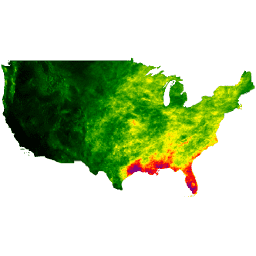
- Доступность набора данных
- 1991-01-01T00:00:00Z–2020-12-31T00:00:00Z
- Поставщик наборов данных
- ПРИЗМА / ШТАТ ОРЕГОН
- Климатологический интервал
- 1 месяц
- Теги
- 30-летний
Описание
Ежедневные и ежемесячные наборы данных PRISM представляют собой сетки климатических данных для территории США, созданные климатической группой PRISM в Университете штата Орегон.
Сетки разрабатываются с использованием PRISM (модель регрессии параметров и высоты на независимых уклонах). Интерполяционные процедуры PRISM моделируют изменение погоды и климата с высотой над уровнем моря, а также учитывают влияние прибрежной зоны, температурные инверсии и рельефа местности, которые могут вызывать дождевые тени. Данные станций усваиваются из множества сетей по всей стране. Подробнее см. в описании наборов пространственных климатических данных PRISM .
Группы
Размер пикселя
928 метров
Группы
| Имя | Единицы | Мин. | Макс | Размер пикселя | Описание |
|---|---|---|---|---|---|
ppt | мм | 0,03* | 1046.09* | метров | 30-летнее среднемесячное количество осадков (включая дождь и талую воду) |
tmean | °С | -16.15* | 37.88* | метров | 30-летняя средняя месячная температура (рассчитывается как (tmin+tmax)/2) |
tmin | °С | -21,9* | 29.79* | метров | 30-летняя средняя месячная минимальная температура |
tmax | °С | -10,78* | 46.63* | метров | 30-летняя средняя месячная максимальная температура |
tdmean | °С | -19.07* | 25.22* | метров | 30-летняя средняя месячная температура точки росы |
vpdmin | гПа | 0* | 33.11* | метров | 30-летний средний ежемесячный минимальный дефицит давления пара |
vpdmax | гПа | 0,37* | 94.11* | метров | 30-летний средний ежемесячный максимальный дефицит давления пара |
solclear | МДж м^-2 сут^-1 | метров | 30-летнее среднемесячное значение глобальной коротковолновой солнечной радиации, полученной на горизонтальной поверхности в условиях ясного неба | ||
solslope | МДж м^-2 сут^-1 | метров | 30-летнее среднемесячное глобальное коротковолновое солнечное излучение, полученное на наклонной поверхности | ||
soltotal | МДж м^-2 сут^-1 | метров | 30-летнее среднемесячное глобальное коротковолновое солнечное излучение, получаемое горизонтальной поверхностью | ||
soltrans | Дробь | метров | 30-летнее среднее значение атмосферной прозрачности (облачности) |
Свойства изображения
Свойства изображения
| Имя | Тип | Описание |
|---|---|---|
| PRISM_DATASET_CREATE_DATE | STRING_LIST | Список исходных дат создания для каждой полосы, например: первый элемент — для первой полосы «ppt», второй элемент — для второй полосы «tmean». |
| PRISM_DATASET_TYPE | STRING_LIST | Список типов наборов данных для каждого диапазона |
| PRISM_CODE_VERSION | STRING_LIST | Список версий кода для каждого диапазона |
| PRISM_DATASET_FILENAME | STRING_LIST | Список оригинальных имен файлов для каждой группы |
Условия эксплуатации
Условия эксплуатации
Эти наборы данных PRISM доступны без ограничений на использование или распространение. Климатическая группа PRISM просит пользователей указывать авторство и, где это применимо, указывать PRISM как источник данных. https://prism.oregonstate.edu/terms/
Цитаты
Дейли, К., Халблейб, М., Смит, Дж.И., Гибсон, У.П., Доггетт, М.К., Тейлор, Г.Х., Кёртис, Дж. и Пастерис, П.А. 2008. Физиографически чувствительное картирование температуры и осадков на всей территории США. Международный журнал климатологии, 28: 2031–2064 , doi:10.1002/joc.1688, pdf .
[Дейли, К., Дж. И. Смит и К. В. Олсон. 2015. Картографирование климатологии атмосферной влажности на всей территории США. PloS ONE 10(10):e0141140. doi:10.1371/journal.pone.0141140 .
DOI
Исследуйте с Earth Engine
Редактор кода (JavaScript)
var dataset = ee.ImageCollection('OREGONSTATE/PRISM/Norm91m'); var precipitation = dataset.select('ppt'); var precipitationVis = { min: 0.0, max: 300.0, palette: ['red', 'yellow', 'green', 'cyan', 'purple'], }; Map.setCenter(-100.55, 40.71, 0); Map.addLayer(precipitation, precipitationVis, 'Precipitation');
